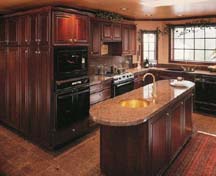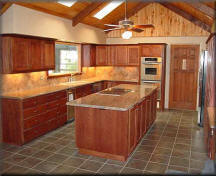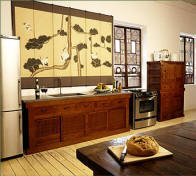The best cabinets online
Custom Cabinetry for Your Kitchen
Custom Cabinets for Your Bathroom
Custom Vanity Tops and Countertops
The development in the southern states was quite different, but then, so were the climate and sociological conditions. In southern estates, the kitchen was often relegated to an outhouse, separated from the mansion, for much of the same reasons as in the feudal kitchen in medieval Europe: the kitchen was operated by slaves, and their working place had to be separated from the living area of the masters by the social standards of the time. In addition, the area's warm climate made operating a kitchen quite unpleasant, especially in the summer.
Completely separated "summer kitchens" also developed on larger farms further north to avoid that the main house was heated by the preparation of the meals for the harvest workers or tasks like canning.
Three basic cabinet groups:
Stock cabinets:
Stock cabinets are available in widths of nine inches and increase in three-inch increments up to 48 inches (the largest standard size stock cabinet you can buy). They are available in a large variety of styles and can be ordered through retailers and manufacturers' catalogs. Keep in mind that stock cabinets are constructed before being purchased, so special sizes are not available. Since this is the case, filler strips are used to close gaps between a cabinet and an appliance or wall. Stock cabinets are typically stored in a manufacturer's warehouses and are usually available within a week of being ordered.Semi-custom cabinets:
Semi-custom cabinets are the best of both worlds. Construction of the cabinet only begins when the order is final. This allows for modifications to standard sizes. However, the delivery time make take a month or longer. An experienced kitchen designer can offer you numerous options - such as interior finishes that match exteriors and varying cabinet depths - that will give your kitchen an almost custom look.Custom cabinets:
Custom cabinets can be made to suit any room space or desire. You can also incorporate virtually any door style and color into your kitchen. You can even have cabinets made to match existing cabinetry, woodwork or architectural details. You can even select an "unfitted" look with freestanding cabinets that look and act like furniture. How long can you expect to wait for you custom cabinets? Plan on at leas 10 weeks, however longer waits are common.
Custom Cabinetry for Your Kitchen?
Cabinets have the single greatest impact on a kitchen or bathroom. Custom cabinets are popular for that reason. People are realizing that whether their room is large or small, elaborate or simple, high quality cabinetry will make it the best that it can be. Custom cabinetry is a one-of-a-kind reflection of your good taste. But is it your only option?
Kitchen cabinets are the built-in furniture installed in many kitchens for storage of food, cooking equipment, and often silverware and dishes for table service. Appliances such as refrigerators, dishwashers, and ovens are often integrated into kitchen cabinetry.
Christine Frederick published from 1913 a series of articles on "New Household Management" in which she analyzed the kitchen following Taylorist principles, presented detailed time-motion studies, and derived a kitchen design from them. Her ideas were taken up in the 1920s by architects in Germany and Austria, most notably Bruno Taut, Erna Meyer, and Margarete Schütte-Lihotzky. A social housing project in Frankfurt (the Römerstadt of architect Ernst May) realized in 1927/28 was the breakthrough for her Frankfurt kitchen, which embodied this new notion of efficiency in the kitchen.
While this "work kitchen" and variants derived from it were a great success for tenement buildings, home owners had different demands and didn't want to be constrained by a 6.4 m² kitchen. Nevertheless, kitchen design was mostly ad-hoc following the whims of the architect. In the U.S., the "Small Homes Council", since 1993 the "Building Research Council", of the School of Architecture of the University of Illinois at Urbana-Champaign was founded in 1944 with the goal to improve the state of the art in home building, originally with an emphasis on standardization for cost reduction. It was there that the notion of the "kitchen work triangle" was formalized: the three main functions in a kitchen are storage, preparation, and cooking (which Catherine Beecher had already recognized), and the places for these functions should be arranged in the kitchen in such a way that work at one place does not interfere with work at another place, the distance between these places is not unnecessarily large, and no obstacles are in the way. A natural arrangement is a triangle, with the refrigerator, the sink, and the stove at a vertex each.
This observation led to a few common kitchen forms, commonly characterized by the arrangement of the kitchen cabinets and sink, stove, and refrigerator:
- A single file kitchen has all of these along one wall; the work triangle degenerates to a line. This is not optimal, but often the only solution if space is restricted.
- The double file kitchen (also known as galley or corridor) has two rows of cabinets at opposite walls, one containing the stove and the sink, the other the refrigerator. This is the classical work kitchen.
- In the L-kitchen, the cabinets occupy two adjacent walls. Again, the work triangle is preserved, and there may even be space for an additional table at a third wall, provided it doesn't intersect the triangle.
- A U-kitchen has cabinets along three walls, typically with the sink at the base of the "U". This is a typical work kitchen, too, unless the two other cabinet rows are short enough to place a table at the fourth wall.
- The block kitchen is a more recent development, typically found in open kitchens. Here, the stove or both the stove and the sink are placed where an L or U kitchen would have a table, in a freestanding "island", separated from the other cabinets. In a closed room, this doesn't make much sense, but in an open kitchen, it makes the stove accessible from all sides such that two persons can cook together, and allows for contact with guests or the rest of the family, since the cook doesn't face the wall anymore.
Modern kitchens often have enough informal space to allow for people to eat in it without having to use the formal dining room. Such areas are called "breakfast areas", "breakfast nooks" or "breakfast bars" if the space is integrated into a kitchen counter. Kitchens with enough space to eat in are sometimes called "eat-in kitchens".
Custom Cabinetry for Your Bathroom?

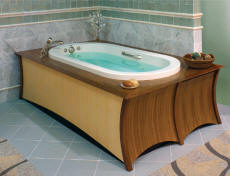
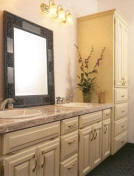
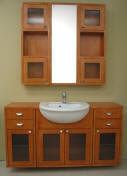
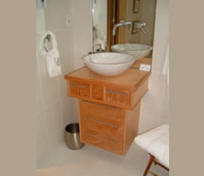
There are bathroom vanities of a number of different varieties, and the name for them has a rather funny and interesting origin. The word vain means proud or narcissistic, and those who are proud of their looks or over infatuated with themselves are often referred to as vain people. So the person who likes to primp and look at themselves in the mirror alot is a person often considered to be invested with more than their fair share of vanity, and for those persons, the bathroom furniture to enable them to admire themselves and do things to make themselves look dandy before going into public was created and aptly named the vanity.
The bathroom vanities of modern times probably really got their foot in the door of our bathrooms during the Victorian era, when women of means and wealth would have hand maids to help them dress and decorate themselves, and these hand maidens would usually sit the woman down on a chair and surround her with mirrors and make up and her wardrobe. So furniture became a part of getting dressed, and especially when the hair had to be done in ways that took much labor and time. Even today, doing hair and make up takes some people hours, and this is why people like to have nice comfortable chairs and other furniture, in the form of bathroom vanity areas, to help them accomplish this kind of work and labor of vanity with ease and as much comfort as possible.
In fact, one of the most popular and elegant types of bathroom vanities incorporates a wing chair, which is a chair that was originally designed for comfort for sitting for long periods of time reading or relaxing. Many people find that this kind of chair is ideal for their bathroom vanity area, as long as it fits well with a small desk that has a really good mirror and great lighting and lot of little places to store various lotions, crèmes, lipsticks, and other tools and tricks of the make up trade.
To learn more about the history and design of bathroom vanities, just look through the Internet, doing searches for history and bathroom accessories and that sort of thing, and you can view all sorts of interesting and elaborate old fashioned vanities. You might even get some good ideas for creating your own one, in modern times, drawing upon Victorian ideas.
Shoping for custom vanity tops, marble, granite, soapstone, slate countertops? here are some good places to start looking:
Shoping for custom vanity tops, marble, granite, soapstone,slate countertops? here are some good places to start looking:
